Our Wandering Palate Melbourne correspondent, Matthew Wilson, goes mushroom hunting down on the Mornington Peninsula armed with a bucket load of local pinot noir.
For an eight week window following Easter each year we witness an autumnal explosion of mushroom bloom on the Mornington Peninsula. Amongst the imported European Pines, a vast array of forest fungi flourish and push through the natural compost, enticed by ample humidity (being a slender peninsula) and the nourishing humus.
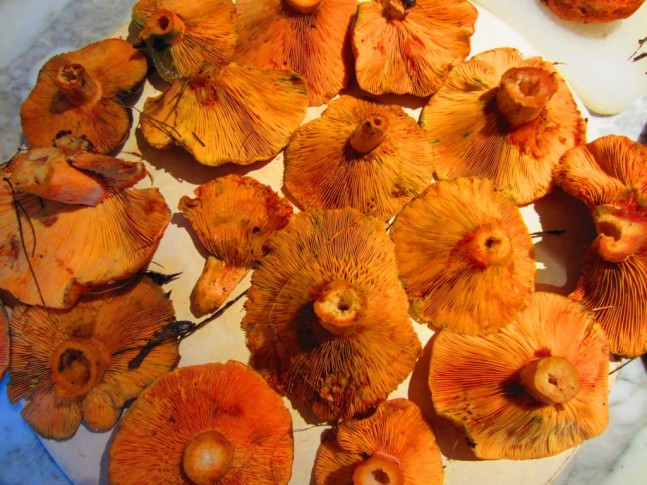
Saffron Milk Caps/Pines (lactarius deliciosus)
Two wine mates and I decided to make a weekend of wine, food and fungi.
Saturday was wine and dinner …
We enjoyed a leisurely drive visiting five wineries:-
1) Paringa Estate … http://www.paringaestate.com.au/
2) Paradigm Hill … http://www.paradigmhill.com.au/
3) Port Phillip Estate … http://www.portphillipestate.com.au/
4) Eldridge Estate … http://eldridge-estate.com.au/
5) Main Ridge Estate … http://www.mre.com.au/
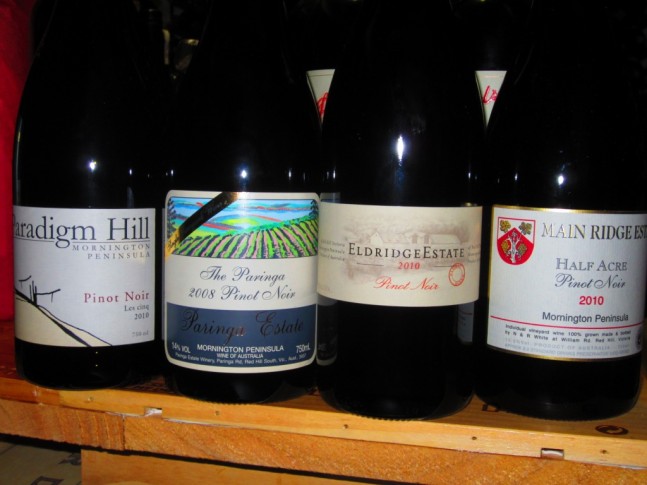
Line-Up of Fine Mornington Pinot
And then Sunday was Mushroom “Hunt & Brunch” at the Merricks General Store – http://www.mgwinestore.com.au/
Up bright and early Saturday morning I hop into the car and head down to the Peninsula – a tad under weather after Richmond defeated St. Kilda, in a hard fought battle to the final siren – go tigers! En route I pick up a basket of freshly imported Porcini and Morels from Stewart Plant, Fine Wine Merchant, Mornington – http://www.finewinemerchant.com.au/ – to accompany our Tasmanian Angus Beef on the barbeque.
First stop is Paringa Estate, and by chance, owner and winemaker, Lindsay McCall is manning the cellar door. Established in 1985, Lindsay has just celebrated his 25th vintage. Whilst chatting to Lindsay we move through the full range of wines, the Estate Riesling is always a dark horse that ages very well; the 2011 vintage shows hints of citrus and a racy palate with a touch of residual. The reds, in particular the single vineyard series, are some of my favourites on the Peninsula, never shy of fresh fruit. The 2008 Single Vineyard Pinot Noir is spicy cherries and a flash of mocha, on the palate bright fruit is intermingled with acid and tannin. The 2008 Single Vineyard Shiraz is perhaps the best shiraz of the region – white pepper, lush red fruits and a suggestion of vanilla. Plum and tannin drive through the palate.
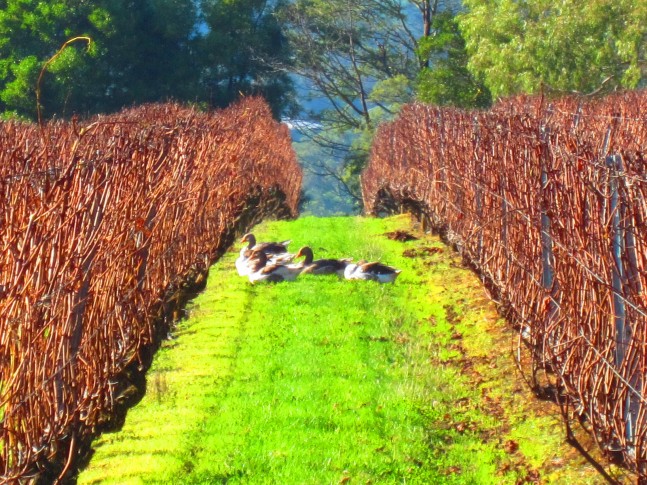
Paringa Estate Geese
Paradigm Hill is only open on the first weekend of each month, and June is the first opportunity to taste the just released 2010 Pinot’s – “Les Cinq” and “L’Ami Sage”. The 2010 vintage is being hailed by some as possibly the best ever on the Peninsula. George and Ruth Mihaly left established careers in medical research and food, respectively, to follow their passion. Tasting wine at Paradigm Hill is indeed a pleasant experience, as each wine is paired with a morsel of food whilst one takes in the view down the valley. The two pinots are grown, harvested and vinified in exactly the same fashion – yet they are strikingly different. “Les Cinq” in minute quantities, represents the terroir of the 5 most westerly and elevated rows – is seductive and feminine – cherry, spice, acid and structure in elegance – I will be brave and say a tad Burgundian. While the “L’Ami Sage”, the bulk of the pinot block, is more overt and muscular – fruit power with a more distinct structure – a more typical Antipodean Pinot expression.
Port Phillip Estate is the Peninsula’s answer to a Napa Valley cellar door – bold and striking architecture sweep across the ridge and offer impressive views of undulating vineyards and Westernport Bay. A fantastic restaurant and swank accommodation fill out the proposition. This is an impressive destination. Home to both the Port Phillip Estate and Kooyong labels, Sandro Mosele, winemaker, produces some of the more distinctive wines of the Peninsula. But unfortunately, the 2009 Single Vineyard Series Pinot Noir’s (Ferrous, Haven and Meres) had sold out and the eagerly awaited 2010’s are not due for release until August 2012. We will return then. We whizzed through the available portfolio of wines – the 2009 Single Vineyard Kooyong Farrago Chardonnay is citrus sorbet, slatey minerality with a dash of cream. The 2009 Port Phillip Estate Morillon Pinot Noir is all cherries (indeed a feature of the Port Phillip Pinots) – bright, lifted and savoury.
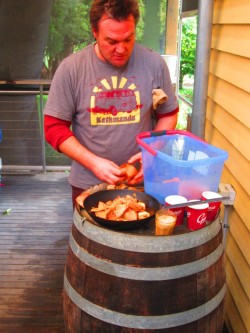
Chef David
Eldridge Estate is a mere 3 hectares of Pinot, Gamay and Chardonnay. David Lloyd’s Clonal Pinot and Chardonnay are highly sought after and we were not disappointed. Clone 96 Chardonnay 2010, a tiny production, shows complexity with nuts and white stone fruit. The palate is broad and deep, acid cuts deftly through ample fruit and a long finish. Clonal Blend Pinot Noir 2010, also a tiny production, comprises almost equal amounts of 5 clones (MV6, 114, 115, 777 and G5V15). The great year manifests itself in the glass – vibrant cherry and exotic spice. A prestigious palate with age worthy hallmarks – acid, tannin, ripe bright fruit and super length.
Main Ridge, also only 3 hectares under vine, was one of the first commercially planted vineyards established in 1975; first vintage was 1980. The 2010 Pinots – “Half Acre” and “The Acre” – are already asleep in my cellar and alas were not available for tasting. The 2010 Chardonnay is distinctively Main Ridge – barrel ferment, secondary malo and prolonged ageing on yeast lees is precisely handled (with the diligence of an ex-engineer) and hence we enjoy a wine of superb texture – fragrant peach with a touch of citrus, fine acidity and a classy creamy round finish. Main Ridge was originally planted to produce a Bordeaux blend, but conditions never suited. Now, only the Merlot remains and in exceptional years, one barrel is produced. The 2010 Main Ridge Merlot has strong structure, dark fruit and broad acid. The palate has a touch of greenness, characteristic spice and plum fruit. This could age in a very interesting manner.
Then it was back to the house at Rye to fire up the BBQ and hop into our stash of wine – three blokes and eight bottles of wine – a busy evening.
With rich and creamy homemade potato and leek soup – 2008 Louis Moreau “Les Fourneaux” 1er Cru, was initially a tad cold and closed but with coaxing revealed classic Chablis minerality and stone fruit. The 2008 Bonny Doon Le Cigare Blanc is lively and textural. Roussanne and Grenache Blanc weave mango and nectarine into a long finish.
I am enjoying Beaujolais at present, and thought one would be fine introduction to Porcini and Morels – 2010 Jean-Marc Burgaud, Morgon Cote du Py, Reserve is young, grippy and plummy. Porcini’s (boletus edulis) were then sautéed in organic butter – wow – a heady mix of meat, cream and nutty richness. Morel’s (morchella) followed in the pan – brainy like bullets of nutty rich earth.
After resting all day and coming to room temperature, three kilo’s of prime Angas beef was thrown on the BBQ – medium rare with loads of cracked pepper and salt. Three Grenache blends had their corks removed. The 1995 Chateau Beaucastel was classic Rhone – leather and earth notes jump out of the glass with a touch of herb, dense palate with fruit, smoke, minerals and meat. The 1996 Clarendon Hills Old Vines Grenache was rich and powerful, and while lacking the complexity of the Beaucastel, the lashings of fruit and smooth tannins were enjoyed. The 1997 Domaine de la Janasse Cuvee Vieilles Vigne was red fruits and brooding earthy tones – and then the memory begins to fade as the alcohol takes over – and fortunately the Grenache based Noon Tawny was left (all 19% alcohol of it) for another day.
Bed.
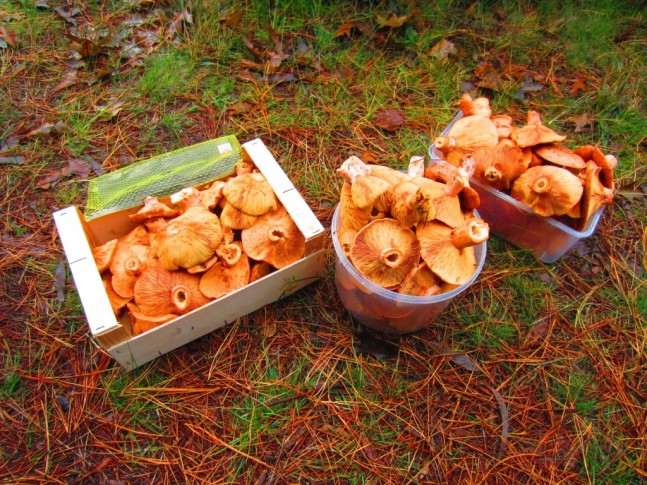
Our haul
Sunday was mushroom madness – with a dash of Pinot …
Sunday morning at 11am has us at the Merricks General Store for “Hunt & Brunch with chef David McLellan”. A punchy long macchiato kicks the engine over and we head off down the pine lined roads and lanes of Merricks in search of Slippery Jack’s (suillus luteus) and Saffron Milk Caps/Pines (lactarius deliciosus).
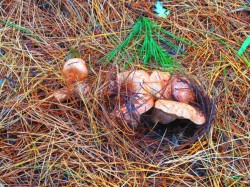
Saffron Cluster
David McLellan is one of three fungi experts, along with T’Gallant and Moorooduc Estate, that conduct mushroom foraging expeditions on the Mornington Peninsula during the autumn months. The area is prime mushroom real estate with both the ideal climate and requisite trees (European Pines). Because the saffron milk cap grows in a mycorrhizal association with pines and spruce it will only grow in forests established with spores. Therefore, it is said, that when the Europeans transplanted the Pines, around 100+ years ago, the fungi spores were captured in the transferred root/soil clumps – fortunately for us.
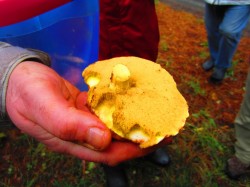
Slippery Jack
The photo’s clearly depict the Saffron Milk Caps. Unfortunately, it was too wet and late into the season for many Slippery Jacks.
Saffron Milk Caps have an orangey pink appearance and a hollow stem which is a popular hangout for critters such as slaters, slugs and earwigs inter alia. They bruise easily when handled and develop a green stain and when broken they ooze an orange/ saffron coloured sap. Sometimes the saffron milk cap is confused with a lookalike mushroom called lactarius deterrimus. This is less palatable. There are also some poisonous lookalikes such as the woolly milk cap (lactarius torminosus).
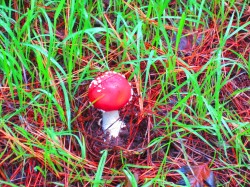
Prettier but toxic
The array of mushrooms was truly astonishing – field and forest alike – most of them severely poisonous and many of them strikingly beautiful. An expert was a must have. Indeed, I was surprised to learn that our guide David doesn’t even touch field mushrooms given the risks.
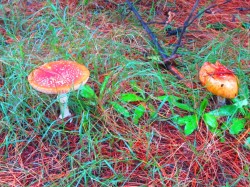
Pretty but poisonous
Renowned mushroom expert Alison Pouliot – http://www.alisonpouliot.com/projects_fungi_ecology.php – says there are about 11,900 species of fungi in Australia, of which only 10% are named. Alison’s tip is to stick to the three well-known edible mushrooms: 1) Saffron milk cap, 2) Slippery jack, and 3) Ink cap, sometimes called lawyer’s wig (coprinus comatus). Mushroom toxicity can vary from slight gastrointestinal discomfort to death. The old adage works well – “if in doubt, go without”
In close to 30 mins, the 20 people in our group all have baskets full of Saffron Milk Caps – free food, in abundance – David’s tip was to pick the smaller fresher younger specimens as the larger bruise easily and taste a tad acrid.
Then it was back to Merricks General Store for brunch.
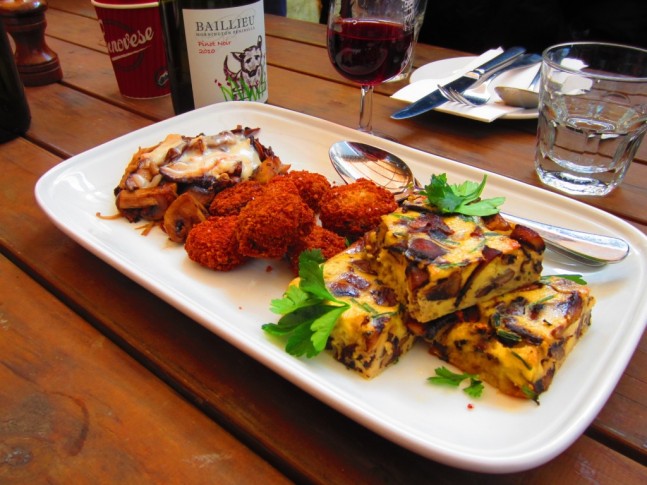
Mushroom Brunch
We were greeted by a cup of warm intense peaty mushroom soup. This was followed by mushroom fritters, mushroom frittata and wild mushrooms sautéed with a dash of cheese and washed down with 2010 Baillieu Vineyard Pinot Noir – bright fruit, uncomplicated palate, eminently gluggable.
David then explained how to prepare the Saffron Milk Caps – brush off dirt and foreign matter, break the cap into small pieces and discard the hollow stem, sauté in olive oil and garlic until the mushroom’s juices are released – then add plenty of butter, parsley, thyme, pepper and salt (I recommend loads of Murray River Salt Flakes) and allow the mushrooms to then absorb the seasoned jus … serve on hot buttered toast with a squeeze of lemon – a firm but tender texture with a mild woody pine meaty flavour.
An awesome weekend.
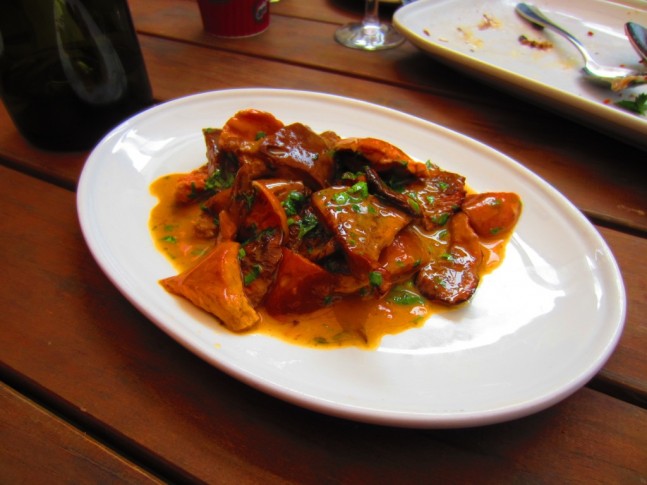
Saffron Brunch
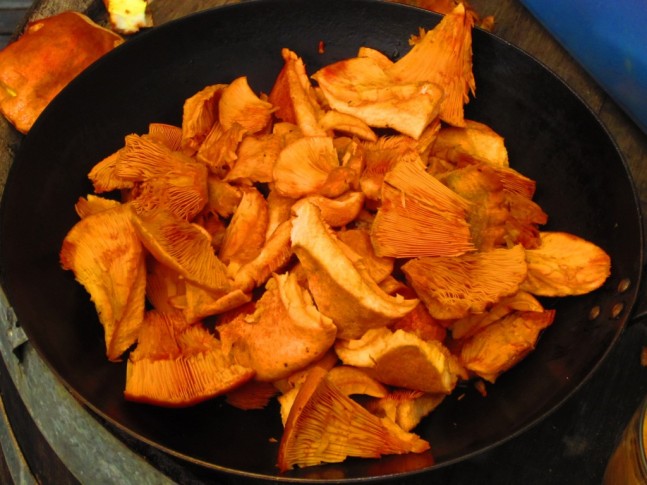
Saffrons in pan
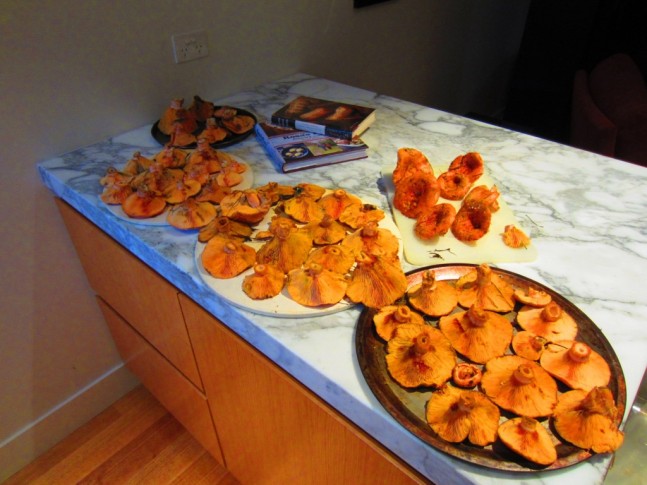
Haul Home
|
|
Tweet |





No comments to Mushroom Madness on the Mornington Peninsula (Southern Victoria, Australia) | Comments Feed
No comments yet
The comments are closed.